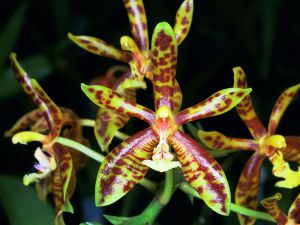No edit summary |
No edit summary Tag: wikieditor |
||
| (7 intermediate revisions by 2 users not shown) | |||
| Line 1: | Line 1: | ||
[[File:Phalaenopsis_mannii.jpg|thumb|Phalaenopsis mannii]] | [[File:Phalaenopsis_mannii.jpg|thumb|''Phalaenopsis mannii'' (not my photo)]] | ||
'''Code:''' PHAL.0x0006 | |||
'''Common Name:''' Mann's Phalaenopsis<br /> | '''Common Name:''' Mann's Phalaenopsis<br /> | ||
| Line 9: | Line 11: | ||
This small to just medium sized, warm to hot growing, epiphytic species is found through the eastern Indian Himalayas, Assam, Nepal, Bhutan, Sikkim, Myanmar, southern China and Vietnam as a pendulous growing epiphyte in tropical valleys at elevations of 500m to 1500m in humid broad-leafed evergreen forests with dense undergrowth near streams and rivers on rough barked trees even though there is not much falling rain. They are best grown slabbed on cork or tree fern because of their pendant growth habit with a short stem enveloped by imbricating leaf bases carrying 4 to 5, oblong-oblanceolate to oblong-ligulate, shiny, fleshy, acute, medium green leaves. They like shady areas with high humidity and a distinctly drier winter rest that helps initiate spring blooming on a slender, pendulous, to 45cm long, racemose or rarely paniculate, laxly many [to 70] flowered inflorescence that is as long as the leaves with small ovate-lanceolate bracts with fragrant, waxy, long-lived flowers appearing in succession. | This small to just medium sized, warm to hot growing, epiphytic species is found through the eastern Indian Himalayas, Assam, Nepal, Bhutan, Sikkim, Myanmar, southern China and Vietnam as a pendulous growing epiphyte in tropical valleys at elevations of 500m to 1500m in humid broad-leafed evergreen forests with dense undergrowth near streams and rivers on rough barked trees even though there is not much falling rain. They are best grown slabbed on cork or tree fern because of their pendant growth habit with a short stem enveloped by imbricating leaf bases carrying 4 to 5, oblong-oblanceolate to oblong-ligulate, shiny, fleshy, acute, medium green leaves. They like shady areas with high humidity and a distinctly drier winter rest that helps initiate spring blooming on a slender, pendulous, to 45cm long, racemose or rarely paniculate, laxly many [to 70] flowered inflorescence that is as long as the leaves with small ovate-lanceolate bracts with fragrant, waxy, long-lived flowers appearing in succession. | ||
Latest revision as of 16:14, 11 June 2024

Code: PHAL.0x0006
Common Name: Mann's Phalaenopsis
Scented: yes
Light Requirements: deep shade
Temperature Requirements: intermediate to hot
Bloom: spring
Synonyms: Phalaenopsis boxalli Rchb.f 1883; Polychilos mannii (Rchb. f.) Shim 1982
This small to just medium sized, warm to hot growing, epiphytic species is found through the eastern Indian Himalayas, Assam, Nepal, Bhutan, Sikkim, Myanmar, southern China and Vietnam as a pendulous growing epiphyte in tropical valleys at elevations of 500m to 1500m in humid broad-leafed evergreen forests with dense undergrowth near streams and rivers on rough barked trees even though there is not much falling rain. They are best grown slabbed on cork or tree fern because of their pendant growth habit with a short stem enveloped by imbricating leaf bases carrying 4 to 5, oblong-oblanceolate to oblong-ligulate, shiny, fleshy, acute, medium green leaves. They like shady areas with high humidity and a distinctly drier winter rest that helps initiate spring blooming on a slender, pendulous, to 45cm long, racemose or rarely paniculate, laxly many [to 70] flowered inflorescence that is as long as the leaves with small ovate-lanceolate bracts with fragrant, waxy, long-lived flowers appearing in succession.